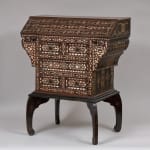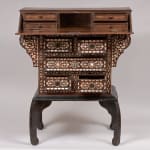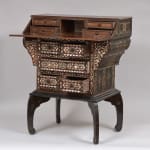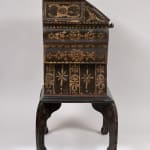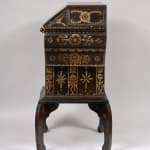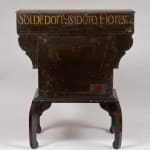WRITING CABINET WITH DROP-DOWN FRONT
86 x 74cm x 52 cm (open)
Further images
Provenance
South American private collection
The piece we have before us here is a wooden writing cabinet or secretaire with a drop-down front panel. The latter is secured towards the top of the middle, where there is a lock fitting. With the front panel down, we can see a structure made up of little drawers or compartments arranged on two horizontal levels, to the left and right, on either side of a central recess. The lower section of the piece, which really sets it apart within this genre of writing cabinets with drop-down fronts, comprises a series of drawers arranged on three vertical levels: two smaller drawers on the first and third levels, and one drawer, twice the size of the others, on the central level. Another striking feature, underscoring the uniquely creative nature of this piece, are the two curvilinear side wings from which the supports for the fold-down panel slide out.
In addition to these highly unusual features, another of the cabinet’s more interesting characteristics is its ornamentation, as it combines the decoration found on the sides, which are painted to imitate oriental lacquer, with the aesthetic of the front of the piece, which has been executed using an inlay marquetry technique known in the Americas as enconchado, which was most widespread in the viceroyalties of Peru and New Spain (Mexico). The outside of the drop-down panel is decorated with a central rectangular section made up of a tortoiseshell plaque with mother-of-pearl inlay, depicting a garland of four-pointed stars and flowers. This central section is surrounded by a thin rectangular wooden frame leading onto a second, larger border, once again featuring tortoiseshell and mother-of-pearl inlay with floral garlands throughout. This sort of decoration based on garlands may also be found on the base structure of the front of the piece, contrasting with the undulating lines, full of movement, with inlay decoration, adorning the drawers and wings, presenting an abundance of leaves, flowers and arabesques. Finally, of its unique characteristics, it is worth highlighting the inscription that has been preserved, and which may be found on the back of the cabinet, reading “Soi De Don Ysidoro Flores” (“I belong to Don Ysidoro Flores”).
Apart from telling us who the owner of this exemplary and previously-unpublished cabinet was, this beautiful inscription acts as a sort of window, to paraphrase Gaston Bachelard’s Poetics of Space, onto the social memory of the period. Although, in terms of their storage capacities, writing cabinets or secretaires were intended to make their owners’ lives easier, there is also no denying they were devised as status symbols aimed at providing necessary recognition for a social elite that was as privileged as it was select. We can therefore conclude that, beyond its aesthetic and technical history, the study of furniture in the Latin American viceroyalties involves a sociological angle, given these sorts of pieces, as luxury items, provide a reflection of the culture, way of life and even way of thinking of the society that produced and enjoyed them.








